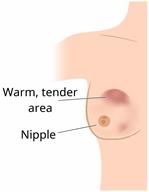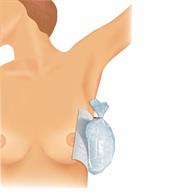Mastitis

Mastitis is inflammation of the breast tissue. It most often happens in females who are breastfeeding. But it can happen to anyone, including males. It will sometimes go away on its own. Other times, mastitis may need treatment.
What are the causes?
In people who are not lactating, mastitis is usually caused by bacteria that gets into the breast tissue through cuts, cracks, or openings in the skin. Sometimes, mastitis can happen when there are no cuts or openings in the skin.
Other causes include:
What are the signs or symptoms?
Symptoms of this condition include:
Swelling, redness, tenderness, and pain in the breast. The area may also feel warm.
Swelling of the glands under the arm.
Nipple discharge.
Tiredness (fatigue), headache, and flu-like muscle aches.
Fever and chills.
Nausea and vomiting.
Symptoms can last 2–5 days. Breast pain and redness are at their worst on days 2 and 3, but can go away by day 5. If an infection develops and is not treated, a collection of pus (abscess) may form.
How is this diagnosed?
Mastitis is often diagnosed based on a physical exam and your symptoms. You may have other tests, such as:
How is this treated?
Treatment may include:
Using hot or cold compresses on the affected area.
Pain medicine.
Antibiotic or steroid medicines.
Self-care, such as rest and drinking more fluids.
Removing fluid from an abscess, if one has formed.
Follow these instructions at home:
Breast care

-
Keep your nipples clean and dry.
- If told, put ice on the affected area.
Put ice in a plastic bag.
Place a towel between your skin and the bag.
Leave the ice on for 20 minutes, 2–3 times a day.
- If told, apply heat to the affected area as often as told by your health care provider. Use the heat source that your provider recommends, such as a moist heat pack or a heating pad.
-
If your skin turns bright red, remove the ice or heat right away to prevent skin damage. The risk of damage is higher if you cannot feel pain, heat, or cold.
Medicines
-
Take over-the-counter and prescription medicines only as told by your provider.
-
If you were prescribed antibiotics, take them as told by your provider. Do not stop using the antibiotic even if you start to feel better.
Contact a health care provider if:
-
You have pus-like discharge coming from the nipple.
-
You have a fever.
-
Your pain and swelling get worse.
-
Your symptoms do not start to get better within 2 days of starting treatment.
-
Your pain is not helped by medicine.
This information is not intended to replace advice given to you by your health care provider. Make sure you discuss any questions you have with your health care provider.

